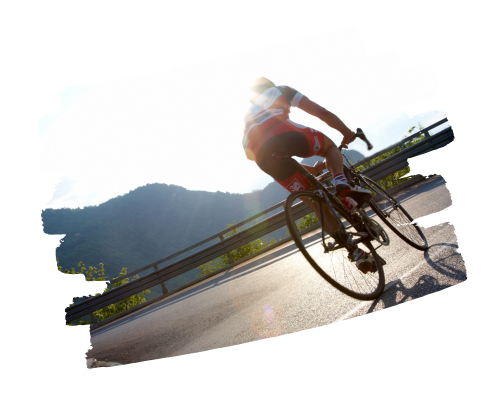Hey there, fellow cyclists! Ever feel like navigating the maze of long-distance cycling training is like trying to climb a steep, never-ending hill? Well, you’re not alone.
I’m Paul Zaldivar, and together with my team of seasoned triathletes, we’ve crunched gears, felt the burn, and emerged stronger. With two decades of experience in triathlons, with cycling as our strong suit, we know about pushing pedals over long distances.
Why should you listen to us? Simple. We’ve been in your cycling shoes.
We’ll delve into long-distance cycling training, offering insights that are as practical as proven. Expect an honest, no-fluff guide that cuts through the noise, providing you with what works.
So, ready to ride this journey with us?
Let’s roll!
Table of Contents
What is Long Distance Cycling Training, and Why is it Important?

Have you ever wondered what it takes to pedal through those awe-inspiring, long-distance rides? Well, strap on your helmet because we’re about to dive into long-distance cycling training and discover why it’s not just about spinning those wheels for miles.
Long Distance Cycling Training: The What and the How
Long-distance cycling training – sounds intense, right? But trust me, it’s as thrilling as it sounds! It’s a meticulous process, like fine-tuning a musical instrument, but in this case, your body and mind are the instruments.
This training enhances physical and mental prowess to tackle those long, winding roads. Imagine being able to cycle further, faster, and with more zest – that’s what this training is all about.
Now, let’s get into the nitty-gritty. This training isn’t just about pedaling endlessly. It’s a mix of varied cycling workouts, each targeting a specific aspect of your performance.
Think of it as a buffet of exercises where each dish contributes to your cycling prowess:
- Aerobic endurance: This is your long-haul fuel. It’s about building stamina to keep those pedals moving.
- Muscular strength: Stronger muscles mean more power to conquer those steep climbs.
- Speed and power: Sometimes, it’s not just about the journey but how swiftly you can zoom through!
- Efficiency: It’s like getting the best mileage out of your car, but in this case, it’s about making every pedal stroke count.
And there’s more! This training also involves cross-training (yes, time to befriend other forms of exercises!), recovery (because your muscles deserve a spa day, too), nutrition, hydration, and, let’s not forget – taking care of your trusty bike. Plus, you’ll be gearing up mentally, strategizing every turn and every push.
Why is Long Distance Cycling Training as Essential as Your Bike’s Wheels?
Now, why should you embark on this training journey? Well, long-distance cycling isn’t just a physical challenge; it’s an odyssey that demands your body and mind to be in perfect harmony. This training is crucial because it prepares you for the real deal – the fatigue, the unpredictable terrains, the whims of weather, and the buzz of traffic.
But wait, there’s a whole bouquet of benefits, too:
- Injury-proofing your body: By training systematically, you’re less likely to hear your muscles scream in protest.
- Boosting your health: Your heart will thank you for the cardio workout, and your muscles will revel in their newfound endurance.
- Enhancing your mood and motivation: There’s a special joy and satisfaction in pushing your limits; this training is your ticket to that euphoria.
Long-distance cycling training isn’t just about getting ready for a ride; it’s about transforming your cycling experience into something more gratifying, healthier, and more exhilarating.
4 Weeks Sample Training Plan for Long Distance Ride
Ready to gear up for that 60-mile ride? I’ve got just the thing – a 4-week training plan to get you road-ready! This plan is a mix of art and science, designed for moderately fit cyclists aiming to conquer 60 miles in 4 hours or less.
This plan isn’t set in stone – think of it as your cycling GPS. It’s based on solid training principles like periodization, specificity, overload, progression, and recovery. But remember, listen to your body and adjust as needed.
Your 4-Week Roadmap
| Week 1: | Week 2: |
| Day 1: Rest. You’ve earned it! | Day 1: Rest. You’ve earned it! |
| Day 2: Tempo Ride (1 hour at 80-90% max heart rate). This is your threshold pusher. | Day 2: Tempo Ride (1.5 hours at 80-90% max heart rate). This is your threshold pusher. |
| Day 3: Interval Ride (30 minutes, including 8 x 1-minute high-intensity intervals). Go hard, then go home. | Day 3: Interval Ride (30 minutes, including 10 x 1-minute high-intensity intervals). Go hard, then go home. |
| Day 4: Recovery Ride (45 minutes, easy spinning). | Day 4: Recovery Ride (45 minutes, easy spinning). |
| Day 5: Rest or cross-training. Your choice! | Day 5: Rest or cross-training. Your choice! |
| Day 6: Long Ride (2 hours at 60-75% max heart rate). | Day 6: Long Ride (2.5hrs at 60-75% max heart rate). |
| Day 7: Recovery Ride (45 minutes, easy spinning). | Day 7: Recovery Ride (45 minutes, easy spinning). |
| Week 3: | Week 4: |
| Day 1: Rest. You’ve earned it! | Day 1: Rest. Let your body catch up. |
| Day 2: Tempo Ride (2 hour at 80-90% max heart rate). This is your threshold pusher. | Day 2: Tempo Ride (1 hour but a notch down in intensity). |
| Day 3: Interval Ride (40 minutes, including 12 x 1-minute high-intensity intervals). Go hard, then go home. | Day 3: Short Interval Ride (20 minutes, with fewer high-intensity intervals). |
| Day 4: Recovery Ride (45 minutes, easy spinning). | Day 4: Recovery Ride (30 minutes, really easy). |
| Day 5: Rest or cross-training. Your choice! | Day 5: Rest or light cross-training. Keep it chill. |
| Day 6: Long Ride (3 hours at 60-75% max heart rate). | Day 6: Shorter Long Ride (1.5 hours at a comfortable pace). |
| Day 7: Recovery Ride (45 minutes, easy spinning). | Day 7: Rest. Get ready for your big ride! |
Feel free to tweak this plan. Adjust the intensity, duration, and types of workouts to fit your level and schedule. Mix in some cross-training, focus on your nutrition and hydration, and don’t forget to pamper your gear.
Remember, This plan is a guide. Always listen to your body, adapt the plan, and consult a healthcare professional if you’re starting a new fitness regime.
How to Execute a Long-Distance Cycling Training Program

It’s time to gear up and hit the road with some best practices to execute your training program. Remember, it’s not just about pedaling; it’s about pedaling with purpose!
Stick to the Plan, but Stay Flexible
Life’s a bit like a bike ride – unpredictable. So, while you stick to your training plan, remain flexible. Weather can turn, injuries happen, and sometimes life gets in the way. Adapt and overcome, just like a steep hill or a sudden downpour.
Warming Up: The Prelude to Success
Before you start each session, remember to warm up. Think dynamic stretches, easy pedaling, or drills. It’s about waking up and preparing your muscles for the journey ahead.
The Core Workouts: Variety is the Spice of Cycling
Long Rides: Your Endurance Foundation
- What: These rides are the bread and butter of your training.
- How: Aim for a moderate intensity, around 60-75% of your maximum heart rate, for 2 to 6 hours or more.
- Why: They build your aerobic endurance, stamina, and efficiency.
- Pro Tip: Gradually increase duration and distance. Mix in some hills, headwinds, or pace changes for extra flavor. Don’t forget to practice your nutrition and hydration strategies!
Tempo Rides: Pushing the Threshold
- What: These workouts are your lactate threshold builders.
- How: High intensity, around 80-90% of your max heart rate, for 20 to 60 minutes.
- Why: Improve your body’s ability to handle fatigue.
- Pro Tip: Maintain a steady and hard pace. You can do these as intervals within a longer ride too.
Interval Rides: Short, Sharp, and Powerful
- What: These are your high-intensity, short-duration bursts.
- How: Go above 90% of your max heart rate for 10 seconds to 5 minutes.
- Why: Boost your speed, power, and anaerobic capacity.
- Pro Tip: Go all out during intervals, then fully recover. Mix these into longer rides for variety.
Recovery Rides: The Art of Rest
- What: Low-intensity, relaxed rides.
- How: Below 60% of your max heart rate for 30 to 90 minutes.
- Why: Aid recovery and prevent burnout.
- Pro Tip: High cadence, low effort. Perfect after a hard or long ride.
After each ride, a proper cool down is essential. Easy pedaling, static stretches, or breathing exercises help lower your heart rate and start recovery.
And use tech to your advantage. A bike computer, heart rate monitor, power meter, or smartphone app can help track your progress. Record speed, distance, time, heart rate, power, cadence, and calories burned. And always tune in to how you feel – fatigue, pain, soreness, or boredom are cues to adjust your training.
Not sure what are the Essentials? Check here!
How to Monitor and Evaluate a Long-Distance Cycling Training Program

Keeping track of your progress in your long-distance cycling training is like having a personal dashboard for your cycling journey. It’s not just about how far or fast you’ve gone; it’s about understanding your performance and how you can shift gears for even better results.
Monitoring Your Progress: The Data Speaks
Data and Feedback: Your Cycling Story
- What to Track: Speed, distance, time, heart rate, power, cadence, calories burned.
- How to Use It: These metrics give you a clear picture of your progress. Are you getting faster? Can you ride longer without feeling like you’ve wrestled a bear?
- Don’t Forget: Your perceived exertion, mood, and enjoyment are just as important. They tell you if you love the ride or if it’s becoming a grind.
Testing and Assessing: The Checkpoints
- Objective Tests: Time trials, functional threshold power tests, lactate threshold tests.
- Subjective Assessments: Monitoring changes in body weight and composition.
- Why It Matters: These tests help pinpoint your strengths and areas where you can improve. Maybe you’re a speed demon, but you must work on endurance.
Here are some of the best bike computers to keep you on track:
Recording and Analyzing: The Bigger Picture
Tools and Methods
- Charts, Graphs, and Tables: Visual aids to track your progress.
- Logs and Journals: For the more detail-oriented. How did you feel during that last ride? What did you eat before?
- Apps: There’s an app for that! Many can track your rides and crunch those numbers for you.
Staying Motivated: Celebrate the Milestones
Strategies and Techniques
- Goal Setting and Feedback: Set mini-goals along the way and celebrate when you hit them. Finished that 20-mile ride? High-five!
- Rewards: Treat yourself. New gear, anyone?
- Social Support: Share your goals and achievements with friends or a cycling group. A little encouragement goes a long way.
Evaluating and Adjusting: The SMARTER Approach
- Specific, Measurable, Achievable, Relevant, Time-bound, Evaluate, and Reward: This isn’t just a mouthful; it’s a recipe for success.
- Review and Revise: Keep your training plan dynamic. What worked last month may not work this month.
FAQs
Q: How Long Does it Take to Train for Long Distance Cycling?
- A: The road to long-distance cycling varies for everyone. Depending on your fitness level, cycling experience, and the goals you’re pedaling towards, it generally takes about 8 to 16 weeks to get in shape for long-distance cycling. The key is to start as early as you can and stick to a training plan that’s progressive and tailored to your needs.
Q: How Often Should I Train for Long Distance Cycling?
- A: Aim to train 3 to 4 times a week to keep those wheels running smoothly. Of course, this depends on your fitness level and cycling experience. Don’t forget to sprinkle in rest days to let your body recuperate. Mix up your workouts in terms of intensity, duration, and type – variety is not just the spice of life, but also of cycling!
Q: What are Some Common Mistakes and Pitfalls to Avoid?
- A: Ah, the bumps on the road! Here are some pitfalls to steer clear of:
- Training Extremes: Avoid going too hard or too easy. Balance is key.
- Lack of Planning: Don’t jump on your bike unprepared. Have a clear goal, route, nutrition, hydration, and equipment plan.
- Ignoring Your Body: Listen to your body’s whispers before they become screams. Fatigue, pain, soreness, or boredom are signs you need to tweak your training.
- Not Tracking Progress: Keep a log of your rides. This data is gold for understanding your performance.
- Forgetting the Fun Factor: Remember why you started cycling in the first place. Enjoy the ride and celebrate every milestone.
Pedaling Towards Your Dreams
Hey, I get it. The road to long-distance cycling mastery can feel like an endless uphill battle.
Maybe you’re sitting there, thinking, “Can I really do this?” Let me tell you something – yes, you can. It’s not just about the miles; it’s about the smiles and the grit in between.
Now that you’re armed with the know-how, it’s time to take that first decisive pedal stroke.
Start with something simple yet significant. Plan your next ride, no matter how short. Feel the breeze, the burn, the exhilaration. That’s your first victory in a series of many.
As you gear up for this journey, remember that every champion was once a contender who refused to give up. You’re not just training for a ride but for life. The resilience, the strength, the endurance you build now will carry you far beyond the roads.
So, stand up on those pedals, feel the power in your legs, the determination in your heart. You’re not just chasing kilometers; you’re chasing dreams. And trust me, when you cross that finish line, it won’t just be a triumph of distance but a testament to your spirit.
Now, go out there and ride like the wind. You’ve got this!

